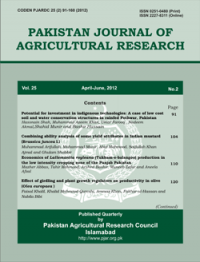BIOCHEMICAL ABNORMALITIES INDUCED BY ABAMECTIN IN SIXTH INSTAR LARVAE OF THE RED FLOUR BEETLE, TRIBOLIUM CASTANEUM (HERBST)
Riaz Hussain*, Muhammad Riaz**, Mushtaq A. Saleem*** and Muhammad Ishaque Mastoi**
ABSTRACT
The sub lethal effects of abamectin (Sure 1.8 EC) were studied on malathion-resistant (PAK) and organophosphate susceptible (FSS-II) strains of Tribolium castaneum (Herbst) (Coleoptera: Tenebrionidae) larvae in the laboratory. The objective was to examine changes in production or activities of carboxylesterase (CE), total esterases (TE), alpha-amylase, glucoamylase, alkaline phosphatase (AkP), acidic phosphatase (AcP), total protein, soluble protein and free amino acids (FAA). The sixth instar larvae of T. castaneum were released and exposed for 48h without food on abamectin treated glass petri dishes. The surviving ones were then homogenized in saline and centrifuged prior to biochemical analyses. Results showed differences in the activities of enzymes and quantities of total protein, soluble protein and FAA between strains and among concentrations. Abamectin, at LC and LC , changed the activities 10 20 /levels of TE, CE, AcP, total protein and FAA in the larvae of both the strains. The activities of alpha-amylase, glucoamylase and AkP remained non-significant at both doses in the two strains. In PAK strain larvae, the TE activity was inhibited with depletion of total protein contents and elevation of FAA contents. In FSS-II larvae, the effect of abamectin on levels of α-amylase, glucoamylase, AkP, total protein and soluble protein remained non-significant. The activities of TE and AcP were reduced at both doses, while activities/levels of CE reduced at LC and FAA increased 10 at LC . It is concluded that abamectin affected the overall body 20 functioning of PAK strain more as compared to FSS-II strain considering disturbances caused in the levels/activities of biochemical components.
To share on other social networks, click on any share button. What are these?






